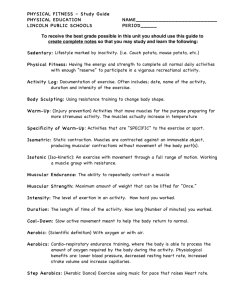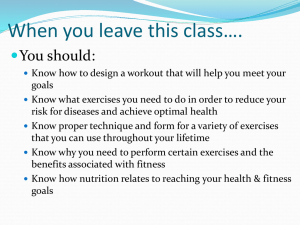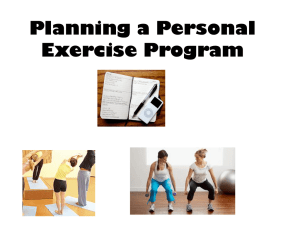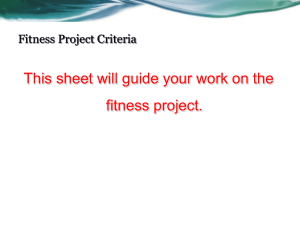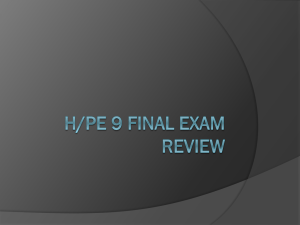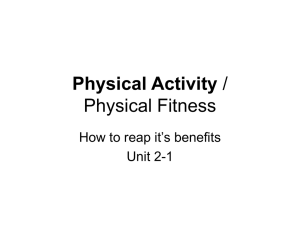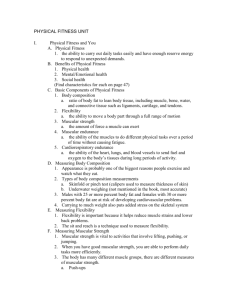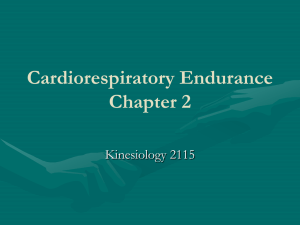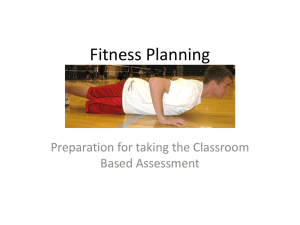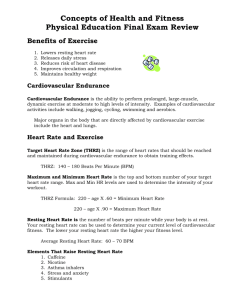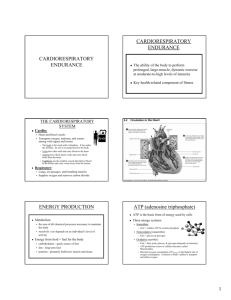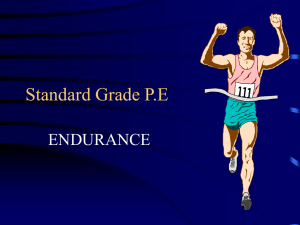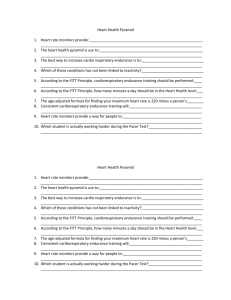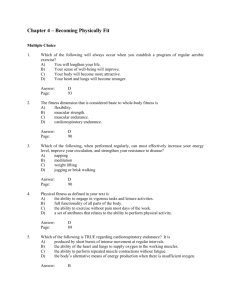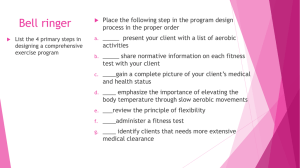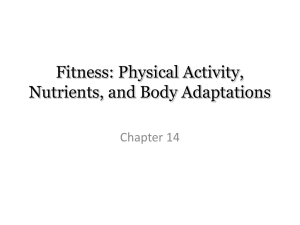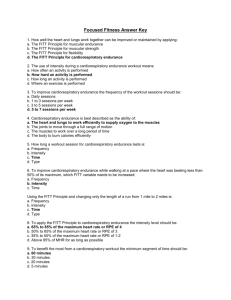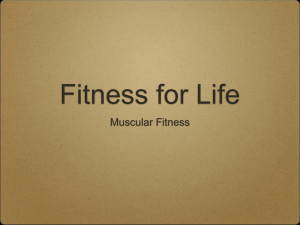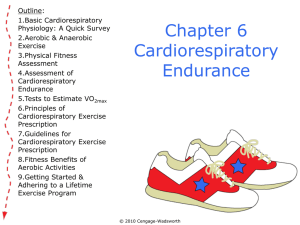vball intro volleyball_intro
advertisement
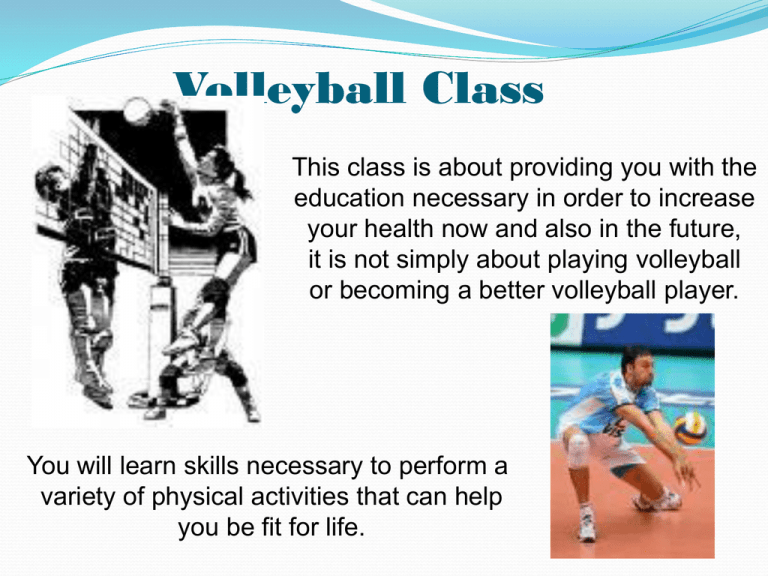
Volleyball Class This class is about providing you with the education necessary in order to increase your health now and also in the future, it is not simply about playing volleyball or becoming a better volleyball player. You will learn skills necessary to perform a variety of physical activities that can help you be fit for life. Health-Related & Skill-Related Fitness • The health-related components contribute to the prevention of lifestyle diseases and promote overall health and fitness. • The components of skill-related fitness are associated with a person’s ability to be able to play games and sports—how well they can perform body functions related to sports-related skills Cardiorespiratory endurance- the ability of the heart, lungs, and blood vessels to use and send fuel and oxygen to the body’s tissues during long periods of moderate-to-vigorous activity Muscular endurance- the ability of the muscles to perform physical tasks over a period of time without becoming fatigued Muscular strength- the amount of force a muscle can exert Flexibility- the ability to move the joints through a full range of motion Body Composition— a comparison of the relative amounts of lean body weight and fat tissue in the body. Agility-the ability to change the position of your body quickly and to control your body’s movements Balance-the ability to keep an upright posture while standing still or moving Coordination-the ability to use your senses together with your body parts or to use two or more body parts together Power -the ability to apply force with speed Reaction Time- the ability to react or respond quickly to a situation and perform the appropriate response quickly Speed- the ability to cover a distance in a short period of time Evaluation of Volleyball Health-Related Fitness Cardiorespiratory Endurance Medium Muscular Endurance High Muscular Strength Medium Flexibility Medium Appropriate body composition Low Skill-Related Fitness Agility High Speed Low Coordination Medium Reaction Time High Power Medium Balance Medium Fitness Testing Standards BOYS Mile Run Pacer Push-up Curl Ups Sit & Reach 8:30 61 20 50 8 Mile Run Pacer Push-up Curl Ups Sit & Reach 10:00 32 7 50 12 GIRLS The FITT Principle The FITT principle provides a framework you can follow for developing an effective exercise program. This principle allows you to design a routine that ensures that you are going to achieve a high level of physical fitness. You are more likely to benefit from exercise if it is designed to meet specific goals and includes at least the minimum amount of recommended exercise. The FITT Principle F: Frequency is the number of times you exercise each week. I: Intensity is how hard you are working while you are exercising. (The effort you put forth.) T: Time is the total amount of time that is spent exercising in one session. T: Type is the type of exercise you are doing—cardio or resistance training. Aerobic or anaerobic exercise. Two Types of Exercise Cardiorespiratory or Aerobic Exercise Continuous activity in which the heart can supply all the oxygen the muscles need. Heart rate remains elevated for a period of time (usually over 15 min). Examples: jogging, swimming, cycling, etc. Resistance Training or Anaerobic Exercise Physical activity done in short, fast bursts in which the heart cannot supply blood and oxygen as fast as muscles use it. Activity that cannot be sustained for a long period of time. Examples: weight-lifting, sprinting, calisthenics (push-ups, sit-ups, jumping jacks, etc.) How Much Exercise? AEROBIC EXERCISE Do moderately intense cardio Moderate-intensity aerobic activity-means you're working hard enough to raise your heart rate and break a sweat. One way to tell is that you'll be able to talk, but not sing the words to your favorite song. 30 minutes a day, five days a week Or Do vigorously intense cardio 20 minutes a day, 3 days a week Vigorous-intensity aerobic activity means you're breathing hard and fast, and your heart rate has gone up quite a bit. If you're working at this level, you won't be able to say more than a few words without pausing for a breath. Benefits of Doing Cardio Physical Benefits: Makes the heart a more efficient pump, reducing the risk of heart diseases. Lowers blood pressure. Helps to burn fat and control body weight. Increases lung capacity Mental Benefits: Improves regulation of stress hormones (feel less stressed) Improves blood flow to the brain, allowing a person to be able to think better Improves mood—reduces the risk of depression Your Heart is a Pump Resting Heart Rate Excellent (elite athlete) Below 50 bpm A well-conditioned athlete Around 60 bpm Average resting heart rate Men=60-80 bpm Women 70-90 bpm Sedentary (poor fitness) Over 100 bpm Cardiorespiratory Endurance Frequency- exercise 3-5 times per week Intensity- train at 60-85% of one’s maximum heart rate Time- 20-60 minutes per session Type- any aerobic activity that keeps heart rate within your target heart zone Examples: Jogging, swimming, cycling, playing basketball or soccer, step aerobics class, etc. Finding Target Heart Rate Zone A simple way to determine your maximum heart rate is to use the following formula: 220 - age = Maximum Heart Rate Maximum Heart Rate An example for a 15 year old person would be as follows: 220 – 15 = 205 205 x .60 = 123 205 x . 85 = 174 Target Heart Rate Zone 123 – 174 This range is what a 15 year old should work at in order to improve cardiorespiratory endurance. How Much Exercise? RESISTANCE TRAINING •Do 8 to 10 strength-training exercises, working different muscle groups •At least 8 to 12 repetitions of each exercise twice a week. Push-Ups Dips Wall Sits Lunges Curls Pull-Ups Sit-Ups Benefits of Resistance Training or Anaerobic Exercise Builds and tones muscles, increases the strength and density of bones Increases muscle mass—which helps to maintain a healthy metabolism Reduces chances for muscle deterioration later in life and less chance of muscle injury Improved sport performance Improved resistance to fatigue Resistance Training Resistance training at least twice per week provides a safe and effective method to improving muscular strength and endurance. It is recommended that 8-10 exercises be performed on two non-consecutive days using the major muscles. The resistance that you use depends upon your personal goals. Goals could be to increase muscle mass, or become more lean and tone, or to increase your vertical jump. Muscular Endurance Frequency-weight train 2-4 times per week Intensity- workout so that you are lifting a weight appropriate for 10-20 repetitions, with little rest time in between lifts Time-a total workout can be about 30-60 minutes (allows enough time to perform 8-10 different exercises about 8-15 repetitions.) Type-an activity that allows the muscles to perform a physical task over a period of time without becoming fatigued (resistance training, Pilates, circuit training, etc.) Muscular Strength Frequency-weight train 2-4 times per week Intensity-for teens, 60%-75% of 1 rep max for 8-12 repetitions Select a weight that you can lift at least 8 times but no more than 12 times. Rest periods between sets are between 1 and 3 minutes long. Do 1-3 sets of 8-12 repetitions for all the major muscle groups. To build strength, you should lift heavier weights (more resistance) with fewer (3-8) repetitions. Time-a total workout can be about 30-60 minutes Type-anaerobic activities -weight lifting, body resistance (sit-ups and push-ups). Flexibility The range of motion that is possible around a joint or joints. The skeletal muscles of the body will shorten over time as a result of poor posture and lack of activity. Proper stretching works to restore the flexibility of a joint by elongating the muscles surrounding the joint. Increased range of motion reduces risk of injury and allows for better athletic performance Flexibility Frequency-daily stretching Intensity-stretch muscles and hold beyond its normal length at a comfortable stretch (hold to tension, not pain) Time- hold stretch for 10-20 seconds . The stretching workout lasts as long as it takes to stretch all the different muscle groups. Type-use stretches that allow the body to move through the full range of motion. Yoga. Question? Why is it important to know and use the FITT principle? Questions? a. What determines the intensity level of a person’s cardio exercise routine? b. What are potential long-term benefits of following a regular cardio exercise routine? Question? What factors need to be considered when designing an individualized resistance training program?
